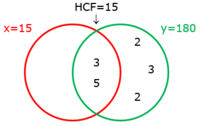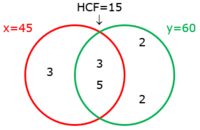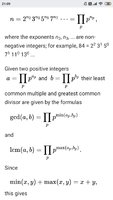Non common factor means which does not fall in the hcf region of two nos . 180 has its hcf 15 and its own factor b as 12 . 12 is the factor that is not common . as 180 is a exact multiple of 15 so all of the factors of 15 are used up and there is no other factor of 15 left that is not used up in hcf region.
NOW in this case all the factors of 15 are common and are in the hcf region there is no factor left . So my intution says a should be zero as a represents non common factor of x ; there is no factor left to be placed in a but that cannot be as x will become zero.
x=15 a
y=15 b so a and b are non common factor" or "the other factor which does not fall in the hcf region .
as shown above ab=12 now the first possible combination of a=1 b=12 will be substitued in x=15a and 15b
as a is coming 1 it should be like x1=15 (common factor) *a ------> x1= 15 *1 so x1 is 15 having common factors (5 *3) and the other non common factor as 1 as a defines non common but 1 is common to every other no so 1 does not fit into the defination of a
Look back at my post #9. I showed all this! The first picture is of the case you are asking about, where there are no prime factors in the left-hand region. That represents,
not 0, but 1: when you don't multiply by anything, it's the same as multiplying by 1. This is the same idea as the 1 you are left with when you cancel all the factors of the numerator of a fraction, like 2/6 becoming 1/3, because you divide both 2 and 6 by their common factor, 2.
And you seem to be correctly recognizing "a" as being 1. That's why I asked whether you had answered your own question.
Now in the last line here you finally show what's troubling you. Your made-up term "non-common factor", which I would call "the other factor" (or the coefficient), can indeed be 1; there is nothing you said in defining what you mean by it that is contrary to that! You seem to be imagining an unstated assumption that a and b have to be products of primes. They simply have to be
relatively prime numbers. That is, they can't have any common factors between them other than 1. And 1 has no factors other than 1 in common with 12, so these are perfectly good.
The standard terms we use have been carefully defined to avoid confusion; you are using some in ways that are confusing you. In part, I think you are confusing "common factors" with "common prime factors"; and by not using the term "relatively prime", which explicitly means "having no common factors
other than 1", and using your term "non-common" which seems to mix together my "other factor besides the HCF" with "having no common factors" probably contributes to the confusion.
So let me restate what we are doing here, more carefully. Given HCF(x,y) = 15 and LCM(x,y) = 180, we let x = 15a and y=15b, where a and b must be relatively prime. (If they were not, then the LCM would not be 15.) Since LCM(15a, 15b) = 15ab, we know that ab = 12. The only ways to factor 12 into two relatively prime factors are (1)(12) and (3)(4). These lead to the two solutions.
Note that I never mentioned primes here. They are useful in my Venn diagram approach, but seem to be getting in your way for the algebraic approach. What I've said here is all that needs to be said. I also didn't need to define a term "non-common factors", which also gets in your way.



